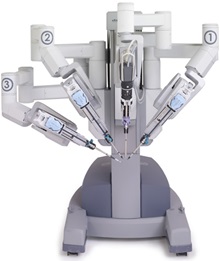
Robotic Surgery in Eau Claire
The da Vinci surgical system provides surgeons in Eau Claire, Wisconsin, with an alternative to traditional open surgery and conventional laparoscopy, putting the surgeon's hands at the controls of an advanced robotic platform. The da Vinci system helps surgeons perform even the most complex and delicate procedures through very small incisions with superior precision.

Surgeons conduct robotic surgery using a robotic system, which includes a camera arm and several interactive mechanical arms, with joints that work like a human's wrist.
From the remote console, the surgeon uses two hand-and-finger devices to precisely direct the mechanical arms at the operating table. He or she leads a trained surgical team during the surgery.
Surgeons have more flexibility, control and maneuverability using the surgical instruments in robotic surgery than in traditional minimally invasive surgery. Using robotic surgery, surgeons can perform delicate and complex procedures that may have been difficult or impossible with other techniques.
Benefits of robotic surgery include:
- Less pain
- Less blood loss
- Less scarring
- Shorter recovery time
- Faster return to normal activities
- Better clinical outcomes in many cases
Types of da Vinci surgery available include:
General surgery
- Cholecystectomy
- Colectomy for colon cancer or diverticulitis
- Gastrectomy
- Gastric bypass for weight loss
- Inguinal hernia repair
- Low anterior resection and abdominal perineal resection for rectal cancer
- Ventral hernia repair
Gynecology
- Endometriosis resection
- Hysterectomy
- Myomectomy
- Removal of ovaries or tubes
Urology
- Bladder diverticulectomy'
- Pyeloplasty
- Radical nephrectomy
- Radical prostatectomy